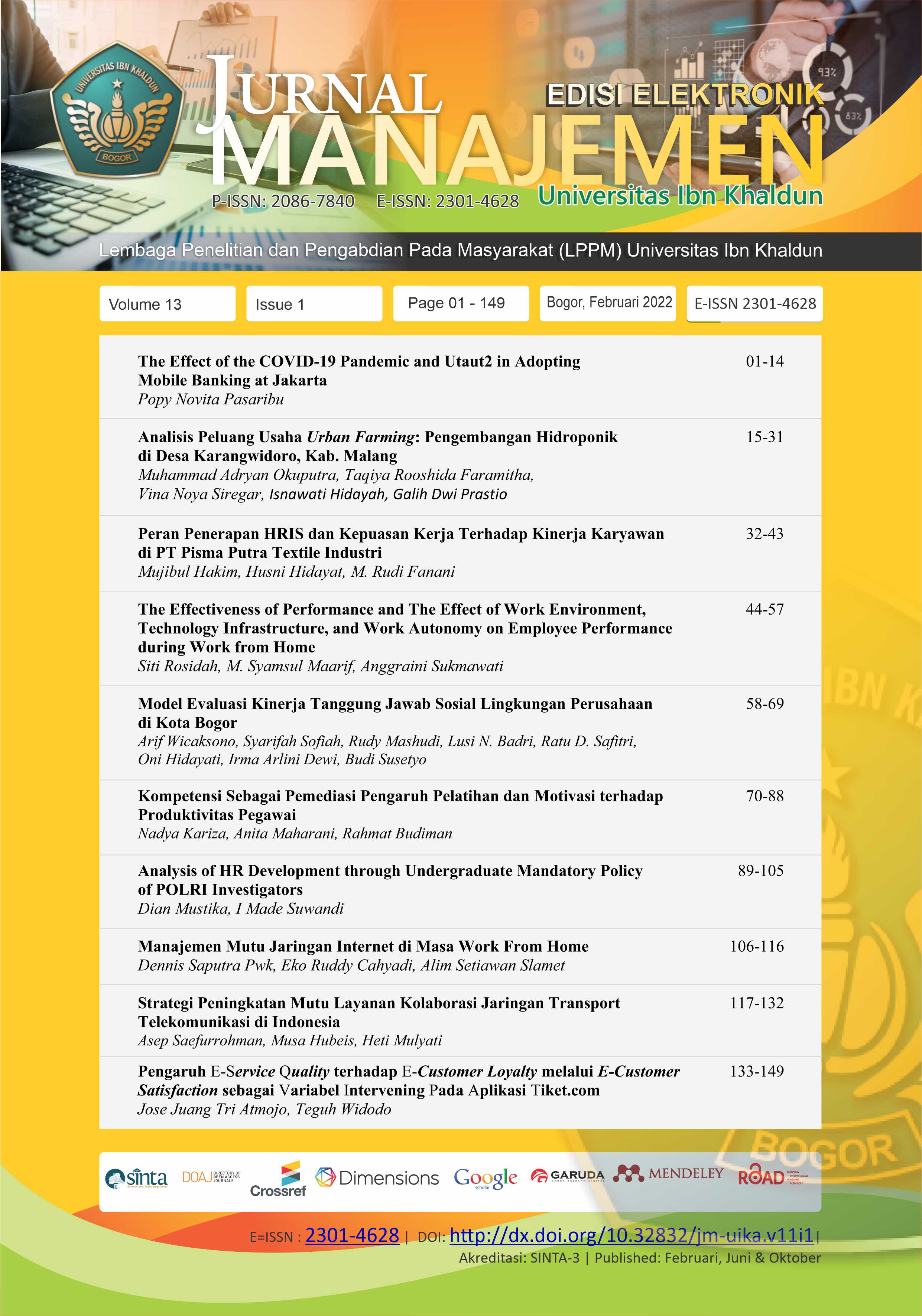Manajemen Mutu Jaringan Internet di Masa Work From Home
DOI:
https://doi.org/10.32832/jm-uika.v13i1.5394Keywords:
Internet, Quality of Service, Telecommunication, Work from HomeAbstract
This study aims to analyze the quality of the internet network during the Work From Home (WFH) period at cellular company. The methodology used in this research is pareto chart, fishbone analysis and comparative test analysis. This research was conducted in the period from December 2019 to November 2020. The variable used in this research is number of complaint, speed, jitter, packet loss and delay. The results of the analysis showed that there was an increase in the number of complaints after the WFH period. In addition, the comparative test showed that packet-loss, delay, jitter and complaints each showed a significant difference between before and after WFH. Otherwise, speed doesn't showed a significant difference between before and after WFH. The implication of this research is cellular company must focus on packet loss, delay, jitter and complaints after WFH because it will affected on quality of internet connection.
References
Agusriandi, A., & Elihami, E. 2020. Developing Delay Jitter, Throughput, and Package Lost: IPERF3 for Learning Islamic Education. Jutkel: Jurnal Telekomunikasi, Kendali dan Listrik, 2(1), 23-30
[APJII]. Asosiasi Penyelenggara Jasa Internet Indonesia. 2019. Buletin Edisi 40. Mei 2019. Jakarta (ID): APJII Publish.
Bandung, Y., Subekti, L. B., Tanjung, D., & Chrysostomou, C. 2017. QoS analysis for WebRTC videoconference on bandwidth-limited network. In 2017 20th International symposium on wireless personal multimedia communications (WPMC) (pp. 547-553). IEEE.
Bobanto W. S., Lumenta A.S. M., dan Najoan, X. 2014. Analisis Kualitas Layanan Jaringan Internet (Studi Kasus PT. Kawanua Internetindo Manado). Jurnal Teknik Elektro dan Komputer. 80-87.
Budiman, E., & Wicaksono, O. 2016. Measuring quality of service for mobile internet services. In 2016 2nd International Conference on Science in Information Technology (ICSITech) (pp. 300-305). IEEE.
Čolaković, A., & Bajrić, H. 2017. ASSESSING CUSTOMER SATISFACTION BASED ON QoS PARAMETERS. International Journal for Quality Research, 11(1).
Frnda, J., Voznak, M., & Sevcik, L. 2016. Impact of packet loss and delay variation on the quality of real-time video streaming. Telecommunication Systems, 62(2), 265-275.
Hafiz, A., & Susianto, D. 2019. Analysis of Internet Service Quality Using Internet Control Message Protocol. In Journal of Physics: Conference Series (Vol. 1338, No. 1, p. 012055). IOP Publishing.
[ITU-T] International Telecommunication Union. 2007. Series E: Overall Network Op-eration, Telephone Service, Service Operation and Human Factors. Geneva : ITU-T
[Kominfo]. Kementrian Komunikasi dan Informatika. 2020. Laporan Tahunan 2020. Jakarta (ID): Kominfo Publish.
Luo, X., Wu, H., Yuan, H., & Zhou, M. 2019. Temporal pattern-aware QoS pre-diction via biased non-negative latent factorization of tensors. IEEE transactions on cy-bernetics, 50(5), 1798-1809.
Muafi, M., & Nilmawati, N. 2014. Budaya mutu dan implementasi ISO 2008: 9001 serta Dampaknya terhadap komitmen organisasional. JDM (Jurnal Dinamika Manajemen), 5(1) : 33-47
Rizqillah, M. H., Herawaty, T., & Tresna, P. W. 2018. The Effect of Brand Trust and Switching Cost Toward Telkomsel Flash Customer Loyalty: A Study on simPATI Users in GraPARI Rawamangun. Review of Integrative Business and Economics Research, 7(3), 210-221.
Rungsrisawat, S., Joemsittiprasert, W., & Jermsittiparsert, K. 2019. Factors De-termining Consumer Buying Behaviour in Online Shopping. International Journal of In-novation, Creativity and Change, 8(8), 222-237.
Rusudin. 2014. Quality of service (qos) pada jaringan internet dengan metode hierarchy token bucket. Jurnal Penelitian Teknik Informatika. 4(1): 210-223.
Ruth E. 2013. Deskripsi kualitas layanan jasa akses internet di Indonesia dari sudut pandang penyelenggara. Buletin Pos dan Telekomunikasi.11(2): 137-146.
Skorin-Kapov, L., & Matijasevic, M. 2010. Analysis of QoS requirements for e-health services and mapping to evolved packet system QoS classes. International journal of telemedicine and applications, 2010
Statista. 2020. Countries with the highest number of internet users 2019. [Internet]. [diunduh pada 3 Februari 2021]. Tersedia pada https://www.statista.com/statistics/262966/number-of-internet-users-in-selected-countries/
Downloads
Published
How to Cite
Issue
Section
License
Authors who publish with this journal agree to the following terms:
- Authors retain copyright and grant the journal right of first publication with the work simultaneously licensed under a Creative Commons Attribution-NonCommercial-ShareAlike 4.0 International License that allows others to share the work with an acknowledgement of the work's authorship and initial publication in this journal.
- Authors can enter into separate, additional contractual arrangements for the non-exclusive distribution of the journal's published version of the work (e.g., post it to an institutional repository or publish it in a book), with an acknowledgement of its initial publication in this journal.
- Authors are permitted and encouraged to post their work online (e.g., in institutional repositories or on their website) prior to and during the submission process, as it can lead to productive exchanges, as well as earlier and greater citation of published work (See The Effect of Open Access).











